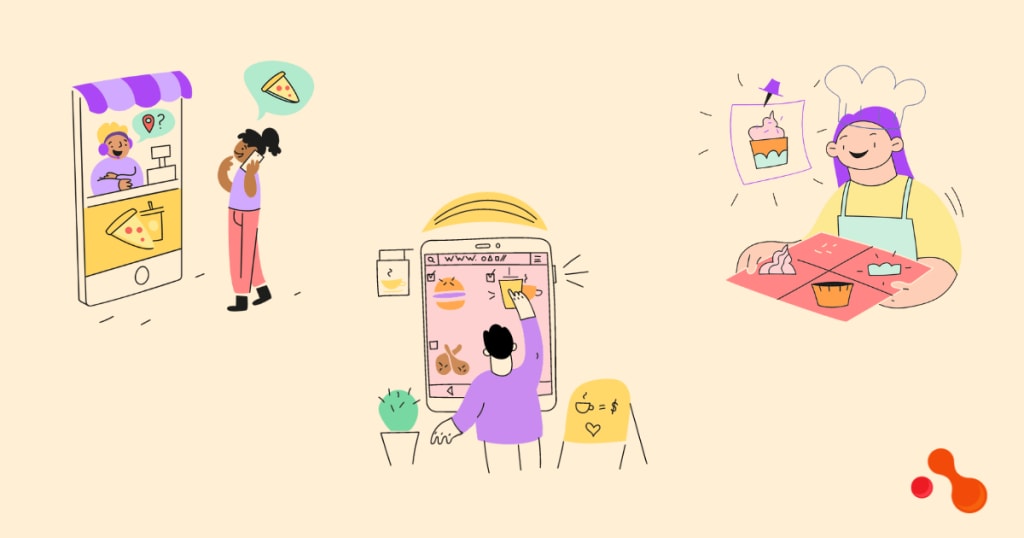Understanding the Logistics of Food Delivery Apps: Behind the Scenes
Food delivery apps have transformed how people order food, offering convenience and accessibility like never before.

Introduction
In today's fast-paced world, food delivery apps have become integral to our lives. With just a few taps on our smartphones, we can have our favorite meals delivered right to our doorstep. However, have you ever wondered what goes on behind the scenes to make this seamless experience possible? In this blog, we will dive into the logistics of food delivery apps and explore the complexities involved in their development and operations. From order placement to delivery tracking, we'll unravel the hidden processes that ensure timely and efficient delivery of your favorite cuisines.
The Rise of Food Delivery Apps
Food delivery apps have transformed how people order food, offering convenience and accessibility like never before. Let's explore these apps' emergence and growth and discuss the industry's key players.
Emergence and Growth of Food Delivery Apps:
- Technological advancements and increased smartphone usage have paved the way for food delivery apps.
- Customers seek convenience and time-saving options, leading to a rise in demand for food delivery services.
- Food delivery apps act as intermediaries, connecting customers with restaurants and enabling seamless ordering and delivery.
Benefits of Food Delivery Apps:
- Convenience: Users can order food from a wide range of restaurants with just a few taps on their smartphones, eliminating the need to cook or dine out.
- Variety: Food delivery apps offer diverse cuisines and menu options from various restaurants, catering to different tastes and preferences.
- Time-saving: Users can save time by avoiding traffic, waiting in long queues, and searching for parking spaces.
- Tracking and Updates: Apps provide real-time order tracking and updates, allowing customers to know their delivery status.
Key Players in the Industry:
- Uber Eats: Initially an extension of the ride-sharing giant Uber. Uber Eats has become a significant player in the food delivery market, partnering with various restaurants worldwide.
- DoorDash: Known for its extensive restaurant network and fast delivery, DoorDash has gained popularity for its user-friendly interface and quick service.
- Grubhub: Operating in over 4,000 cities, Grubhub offers a wide range of food options and provides advanced filtering options for users to find their desired cuisine easily.
- Deliveroo: Initially launched in the UK, Deliveroo has expanded globally and stands out for its delivery fleet, which includes cyclists and scooter riders.
- Zomato: Originating in India, Zomato has expanded to multiple countries and offers a comprehensive platform that includes restaurant discovery, online ordering, and delivery.
Food delivery apps have revolutionized how we order food, providing convenience, variety, and efficiency. With the growing demand for these services, the industry continues to evolve, bringing new players and innovative features to the market.
How Food Delivery Apps Work
Food delivery apps have revolutionized the way people order and receive food. These apps provide convenience and accessibility, allowing customers to order food from their favorite restaurants with just a few taps on their smartphones. Let's explore how food delivery apps work from different perspectives:
A. Customer Perspective:
- Customers download a food delivery app from their app store and create an account.
- They enter their location to view a list of nearby restaurants available for delivery.
- Customers browse through menus, select dishes, customize their orders, and add them to the cart.
- They proceed to checkout, where they can review their order details and choose a payment method.
- After confirming the order, customers receive notifications about the estimated delivery time and can track the delivery in real time.
- Once the delivery person arrives, the customer receives their food and completes the transaction, providing feedback if desired.
B. Restaurant Perspective:
- Restaurants partner with food delivery app development companies or directly integrate with existing food delivery platforms.
- They provide their menu, pricing details, and any specific instructions or restrictions for certain dishes.
- When a customer orders, the restaurant receives the order details through the app or a dedicated tablet.
- Restaurant staff prepares the order, ensuring it meets the app's quality standards and packaging requirements.
- They update the order status on the app, indicating when it's ready for pickup by the delivery personnel.
- Restaurants may also receive ratings and feedback from customers through the app.
C. Delivery Personnel Perspective:
- Delivery personnel join the food delivery app as independent contractors or employees.
- They receive smartphone order notifications, including the pick-up location, customer details, and delivery address.
- Delivery personnel pick up the order from the designated restaurant and confirm the pick-up on the app.
- They find the shortest route to the customer's location using the app's built-in navigation or map integration.
- Delivery personnel ensure prompt and safe delivery and may contact customers for any additional directions or updates.
- After completing the delivery, they update the app to indicate a successful delivery and proceed to the next order.
Food delivery apps simplify ordering and delivering food, benefiting customers, restaurants, and delivery personnel. They provide a seamless experience, delivering delicious meals efficiently to hungry customers' doorsteps.
The Logistics of Food Delivery Apps
Let's delve into the logistics of food delivery apps and find out!
Order Fulfillment:
- Order fulfillment is a crucial aspect of food delivery apps.
- When you order through the app, it goes to the restaurant or the delivery person responsible for delivering the food.
- The app tracks the order's progress, from its preparation to delivery to your doorstep.
- Order fulfillment requires coordination between the app, restaurants, and delivery personnel to ensure timely and accurate deliveries.
Inventory Management:
- Inventory management is another important component of food delivery apps.
- Restaurants must keep track of their stock to ensure they can fulfill the orders received through the app.
- Food delivery apps often collaborate with restaurants to obtain real-time inventory data.
- This helps manage the availability of dishes and prevents customers from ordering items out of stock.
- Efficient inventory management ensures a smooth ordering experience for customers.
Customer Support:
- Customer support plays a vital role in the success of food delivery apps.
- Users may have queries, complaints, or issues about their orders or the app.
- Food delivery apps provide customer support through various channels, such as phone, chat, or email.
- The support team assists customers in resolving their problems promptly and ensures a positive user experience.
- Good customer support enhances the reputation and trustworthiness of the app.
In conclusion, the logistics of food delivery apps involve order fulfillment, inventory management, and customer support. These aspects are essential for the smooth operation and success of these apps. By effectively managing these logistics, food delivery apps provide convenient and hassle-free food ordering experiences.
If you're interested in food delivery app development, you can explore services offered by food delivery app development companies. They specialize in creating robust and user-friendly mobile apps that cater to the needs of both customers and restaurants.
Challenges and Future Trends
Food delivery app development has revolutionized the way we order and receive food. However, like any other technology, it also brings challenges and concerns that must be addressed. This article will explore some of the key challenges and concerns associated with food delivery app development. Let's break them down into easy-to-understand bullet points:
A. High Commission Fees:
- One major challenge faced by food delivery app development companies is the high commission fees they charge from restaurants.
- Restaurants often struggle to cope with these high fees, which affects their profit margins.
- This issue has led to discontent among restaurant owners and has even resulted in some establishments opting out of partnering with food delivery apps.
B. Decreased Direct Customer Interaction:
- Another concern associated with food delivery apps is the decreased direct interaction between customers and restaurants.
- In traditional dining experiences, customers could directly communicate with restaurant staff, ask questions, and make special requests.
- With food delivery apps, this direct interaction is limited, leading to potential misunderstandings or miscommunications regarding orders or preferences.
C. Quality Control Issues:
- Maintaining consistent quality control is challenging for food delivery app development services.
- As the delivery process involves multiple stakeholders (restaurants, delivery personnel, and the app platform itself), ensuring the food arrives promptly and retains its quality can be challenging.
- Factors such as traffic delays, mishandling of food, or improper packaging can lead to a decline in the quality of delivered meals, resulting in dissatisfied customers.
Conclusion
Food delivery apps have revolutionized the way we order and enjoy food. Behind their user-friendly interfaces and quick deliveries lies a complex web of logistics that makes it all possible. From the development stage to the final delivery, various factors combine to create a seamless user experience. The collaboration between food delivery app development companies, restaurants, delivery personnel, and customers is crucial for the success of these apps. As technology advances, we can expect even more innovation in this field, further enhancing the convenience and efficiency of food delivery services.
About the Creator
Mukesh Ram
I founded Acquaint Softtech Private Limited with a vision to make quality developers affordable to everyone. With my blood, sweat, and tears I haven’t just been able to sustain but thrive over the years.






Comments
Mukesh Ram is not accepting comments at the moment
Want to show your support? Send them a one-off tip.